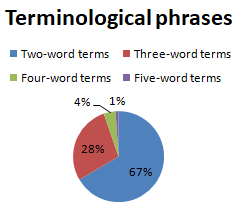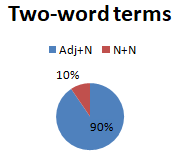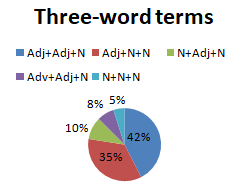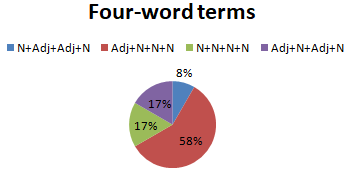Abstract
The aim of the study is to describe the structural features of the terminology of combinatorial linguistics which studies the syntagmatic relations of language units and their combinatorial potential. This article discusses the syntactic method of formation of Russian terms of this field of knowledge. The classification of terminological phrases presented in the terminology of combinatorial linguistics was carried out. In the course of the study two-word, three-word, as well as four-word and five-word terms of the combinatorial field of knowledge were singled out. In addition, we identified the models by which the terminological phrases of the research area were formed. We also found that with an increase of the components in terminological phrases, there is a decrease in the number of units of such structures. It is determined that the most common constructions of terms in combinatorial linguistics are two-word terms. It is revealed that for two-word terminological phrases the most common model of their formation is the construction containing the adjective in the function of a prepositive attribute. A less common construction among such terms is the model of formation in which the noun acts as a postpositive attribute. We established that among the three-word terminological phrases the most frequent formation model is a construction consisting of such components as: adjective + adjective + noun. Less frequent formation models of such terminological phrases are: adjective + noun + noun; noun + adjective + noun.
Keywords: Combinatorial linguistics, terminology structure, term, terminology
Introduction
In the study of the term linguistics took the most active position which subsequently contributed to the identification of terminology and terminography as separate areas. The linguistic problems of the term are quite fully presented in the works of Danilenko, Leychik, Superanskaya, Khayutin, and others. The current stage of the term study is characterized by a detailed study of the field of their functioning – the terminological field (see the works of Grinev, Leychik, Superanskaya, etc.).
This article is devoted to the study of the structural characteristics of the combinatorial linguistics terminology which studies the syntagmatic relations of language units and their combinatorial potential (Vlavatskaya, 2016).
Problem Statement
The relevance of the research consists in the importance and necessity of studying the problems of terminology – one of the urgent tasks of the language science in general and the peculiarities of certain areas of scientific knowledge in particular, in this case, the combinatorial science of language. The terminology of combinatorial linguistics is currently in high demand. As well known, being elements of a single terminological system, terms are combined with each other through structural, lexical-semantic, logical-conceptual and other types of communication, each of which requires a separate study.
Among the problems studied in combinatorial linguistics there are problems related to the functional-speech aspect of language, communication, the formation of word meanings, the creation and interpretation of texts, etc. It is also worth noting the problems that arise in connection with the need to generalize and classify the combinatorial-syntagmatic properties of language units (Vlavatskaya, 2016).
Research Questions
Within the framework of this study, special attention is paid to the terms of the Russian language, formed by the syntactic method, which consists in the formation of complex “word equivalents” (Kazarina, 1998), i.e. terminological combinations of words. A terminological phrase is a “semantic and grammatical combination of two (or several) full-meaning words that serves as the name of a special professional concept” (Averbukh, 2004, p. 142). In terminological studies the predominance of terminological phrases is noted in almost any terminology areas of knowledge (Grinev, 1993; Kazarina, 1998; Manerko, 2000).
Terminological phrases have the following properties (Raisova, 2014): 1) semantic integrity, which consists in the fact that terminological phrases are used to name one concept; 2) stability, since these structures are used “ready-made”. The following types of terminological phrases are distinguished (Grinev-Grinevich, 2008): 1) two-word terms (с); 2) three-word terms (); 3) verbose terms consisting of four or more words ().
Terminological phrases reflect systemic relationships of interconnection and hierarchy which are added between special units of a given area of knowledge and therefore provide an opportunity to convey a greater amount of information than single-component terms. In our study such terminological units are considered as structurally and semantically derived units (Latu, 2009; Razduev, 2013), which are formed on the basis of already existing terminological lexemes of the Russian language.
Purpose of the Study
This article will consider the Russian terms of combinatorial linguistics formed by the syntactic way that determines the purpose of our research.
Research Methods
We used the structural analysis as a research method, which allows us to identify the terminological features in the studied field of knowledge, namely: which types of terms prevail; to establish the ways of forming terms; to single out the word-forming models of terms. In addition, we applied the methods of classification and definition analysis of special units.
The research materials were the Russian terms taken from the theoretical works on combinatorial linguistics (Arkhipova & Vlavatskaya, 2020; Emel'yanova, 2020; Onal, 2020; Tsvenger, 2020; Vlavatskaya, 2016; Vlavatskaya & Zaykina, 2018).
Findings
In the terminology of combinatorial linguistics the following types of terminological phrases were identified (284 terms out of the total number of analyzed terminological units in the field of combinatorial linguistics (344 terms)): 1) terms consisting of two components (two words) (67% of the total number of terminological phrases in combinatorial linguistics – 189 terminological units) (,.); 2) terms consisting of three components (,) (28% – 80 terms); 3) terms consisting of four components (,) (4% – 12 terms); 4) terms consisting of five components () (1% – 3 terms).
The percentage of terminological phrases in the combinatorial linguistics terminology can be seen in Figure 1 below.

The terminology analysis of combinatorial linguistics has shown that two-word terminological phrases are formed from a nuclear element which is represented by a noun in the nominative element and a defining element. The main component of such terminological phrases (for example, the term in the phrase) is the central term of a special field of knowledge, in this case, combinatorial linguistics. Another part of such terms carries a differential specific feature that clarifies the scope of the concept (for example, the word in the phrase). The study of two-word terminological units of combinatorial linguistics has shown that the most common constructions are those in which adjectives and nouns are used as attributes.
To the formation models of two-word terminological units of combinatorial linguistics we assign the following (Grinev-Grinevich, 2008): 1) a terminological phrase in which an adjective acts as a prepositive attribute:, etc. (171 terms); 2) terminological phrases that include the noun in the function of the postpositive attribute: etc. (18 terms).
The percentage of two-word terminological phrases in the terminology of combinatorial linguistics can be seen in Figure 2 below.

Next, let us consider the formation models of three-word terms of combinatorial linguistics. Among such structures we identified the following:
1) terminological phrases consisting of such components as: Adj (adjective) + Adj + N (noun): for example, the terms активная синтаксическая сочетаемость, нормативные кодифицированные словосочетания, необязательная синтаксическая сочетаемость, нормативные узуальные словосочетания, etc. (34 terms);
2) three-word terminological phrases: Adj + N + N: относительная ценность слова, лексическое значение слова, семантические актанты слова, синтаксические актанты слова, описательный словарь сочетаемости, etc. (28 terms);
3) three-word terms consisting of components: N + (Adj + N in the genitive case): словарь речевого употребления, словарь комбинаторного типа, трансформация синтагматических структур, инструментарий комбинаторной лексикографии, история комбинаторной лексикографии, etc. (8 terms);
4) three-word terms consisting of such components as: Adverb + Adj + N: синтаксически обязательная валентность, синтаксически факультативная валентность, синтаксически обусловленное значение, etc. (6 terms);
5) terminological phrases in which the three components are expressed by the nouns: принципы построения синтагмы, принцип линейности речи, принципы описания сочетаемости, распространитель значения слова (4 terms).
The percentage ratio of the three-word terminological phrases in the terminology of combinatorial linguistics can be seen in Figure 3 below.

There are not so many units among the four-component terminological phrases of combinatorial linguistics in comparison with the two-component and three-component terms. We identified the most common construction: Adj + N + N + N, according to which the following terms are formed:, etc. (7 terms). The following construction was also distinguished: N + N + N + N: (2 terms). One more common construction is: Adj + N + Adj +N: (2 terms). The least common constructions among the four-word terminological phrases are the following: N + Adj + Adj + N ().
The percentage of four-word terminological phrases in the combinatorial linguistics terminology can be seen in Figure 4 below.

Terminological phrases with the five components are even rarer in the combinatorial terminology (3 terms): Adj + N + Adj + N+ N (); N + Adj + Adj + N + N (); N + N + Adverb + Adj + N (). In the semantics of terminological phrases in combinatorial linguistics we distinguish integrating and differentiating elements. The integrating element is represented in the terminological phrase as the main component, and the differentiating component carries a distinctive feature. The integrating element expresses the generic feature of the concept and combines the phrases into thematic associations (for example,). In turn, the differentiating element, which has a restrictive property, reveals a distinctive specific feature of the concept. In verbose terminological phrases of combinatorial linguistics further differentiating elements are added to the original two-word term which indicate a subspecies of this type of concept (for example,). In addition, among the verbose terms there are those that represent a single whole (for example,) (Danilenko, 1973).
The structure of a terminological phrase in the field of combinatorial linguistics determines the place of the concept called by it in the system in which its related concepts are located. The generic term, the nuclear element of the phrase, identifies the group to which the concepts called by the phrase belong. This term is defined in the phrase by the case ending, and the process of forming combinations, as a rule, is reduced to adding new words (or phrases) to it (for example,, etc.) (Grinev-Grinevich, 2008).
Conclusion
Thus, the following results have been obtained in the course of our study: 1) terminological phrases of combinatorial linguistics are represented by two-word, three-word and verbose terms; 2) among the verbose terms four-word and five-word terms were also identified which are terminological phrases, but their number is small; 3) the terminology of combinatorial linguistics is mainly represented by two-word terminological phrases.
The study of two-word terms revealed that the most common model for the formation of such constructions is the construction containing the adjective in the function of the prepositive attribute (90% of the total number of two-word terms – 171 terminological units). A less common model for the formation of such terminological units is a construction in which the noun acts as a postpositive attribute (10% – 18 terminological units).
The analysis of three-word terminological phrases showed that the most frequent model of formation is a construction consisting of such components as: Adj + Adj + N (42% of the total number of three-word terms – 34 terminological units). Less frequent models of the formation of such terminological units are the following constructions: Adj + N + N (35% – 28 terms); N + Adj + N (10% – 8 terms); Adverb + Adj + N (8% – 6 terms). The least common model of the formation of three-word terms in combinatorial linguistics is: N + N + N (5% – 4 terms).
The analysis of four-word terminological phrases showed that the most frequent formation model is: Adj +N + N + N (58% of the total number of four-word terms – 7 terms).
All in all, the analysis of the combinatorial linguistics terms revealed that with an increase in the components in terminological phrases there is a decrease in the number of units. Verbose terminological phrases have a clarifying function since they expand the semantic volume of information contained in the terminological unit and also perform an important orienting function.
The study of combinatorial terminology in the structural and syntactic aspect allows us to investigate the structure of terminological units of the given field of knowledge.
As a prospect, we plan to comprehensively study the terms of combinatorial linguistics in order to systematize the terminology of this area of knowledge.
References
Arkhipova, E. I., & Vlavatskaya, M. V. (2020). Digital technologies in the compiling and use of ethnocultural collocations dictionary. Lecture Notes in Networks and Systems, 131, 1092-1099.
Averbukh, K. Ya. (2004). General theory of the term. Ivanovo: Ivanovo State University.
Danilenko, V. P. (1973). About a model of terms and phrases. Scientific and Technical Terminology, 10, 12-13.
Emel'yanova, A. V. (2020). Functional-semantic analysis of occasional collocations in the ode “Bonaparte” by A. de Lamartine. Philology. Theory & Practice, 13, 210-215.
Grinev, S. V. (1993). Introduction to terminology. Moscow Lyceum.
Grinev-Grinevich, S. V. (2008). Terminology. Moscow.
Kazarina, S. G. (1998). Typological characteristics of industry terminologies. Krasnodar.
Latu, M. N. (2009). English-language military terminology in its historical development: Structural-semantic and cognitive-frame aspects [Candidate dissertation].
Manerko, L. A. (2000). The language of modern technology: The core and the periphery. Ryazan State Pedagogical University named after S. A. Esenin.
Onal, I. O. (2020). Combinatorial peculiarities of the lexemes “election” and “secim” in poetical texts of political orientation. Philology. Theory & Practice, 4, 135-140.
Raisova, A. M. (2014). Formation and development of German environmental terminology. OmSTU.
Razduev, A. V. (2013). Modern English Sublanguage of nanotechnology: Structural-semantic, cognitive-frame and lexicographic models [Candidate dissertation].
Tsvenger, L. V. (2020). Colorative collocations and their functions in newspaper headline. Bulletin of Chelyabinsk State University, 1(435), 173-180.
Vlavatskaya, M. V. (2016). Combinatorial linguistics: Aspects of word combinatorial power study. NSTU.
Vlavatskaya, M. V., & Zaykina, Z. M. (2018). Combinatorial paroemiology in the study of new paroemias. Philology. Theory & Practice, 11(89), 88-92.
Copyright information

This work is licensed under a Creative Commons Attribution-NonCommercial-NoDerivatives 4.0 International License.
About this article
Publication Date
02 December 2021
Article Doi
eBook ISBN
978-1-80296-117-1
Publisher
European Publisher
Volume
118
Print ISBN (optional)
-
Edition Number
1st Edition
Pages
1-954
Subjects
Linguistics, cognitive linguistics, education technology, linguistic conceptology, translation
Cite this article as:
Efanova, M. A. (2021). Combinatorial Linguistics Terms In The Russian Language: The Syntactic Method Of Formation. In O. Kolmakova, O. Boginskaya, & S. Grichin (Eds.), Language and Technology in the Interdisciplinary Paradigm, vol 118. European Proceedings of Social and Behavioural Sciences (pp. 312-319). European Publisher. https://doi.org/10.15405/epsbs.2021.12.39

